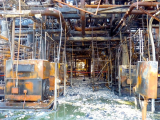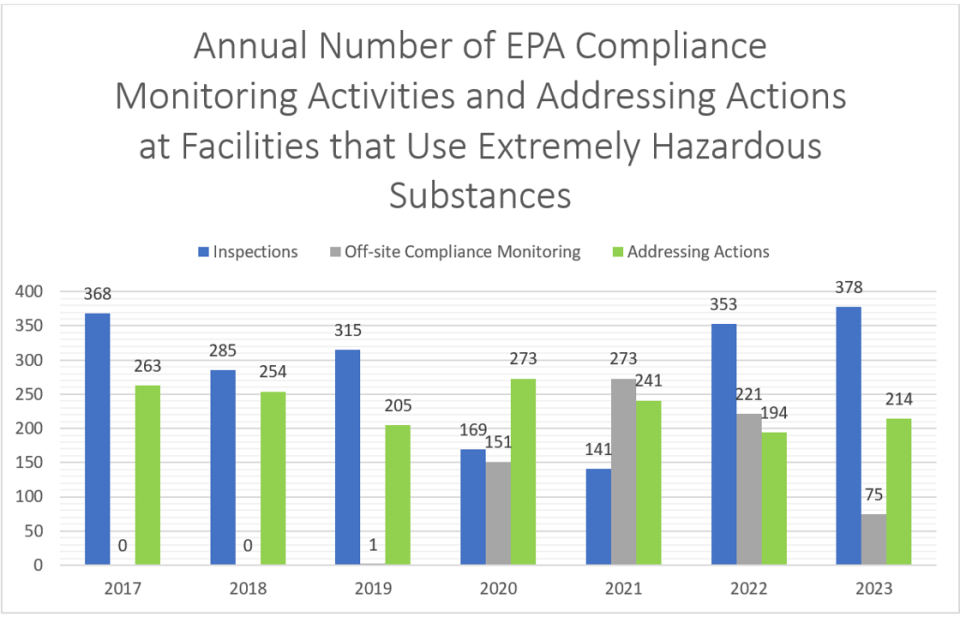National Enforcement and Compliance Initiative: Reducing Risks of Accidental Releases at Industrial and Chemical Facilities
Problem

Thousands of facilities nationwide, many of which are in communities with potential environmental justice concerns, make, use, and store extremely hazardous substances. Catastrophic accidents at these facilities can result in fatalities and serious injuries both on-site and in surrounding communities, evacuations, and other harm to human health and the environment.
These facilities are regulated under the Clean Air Act (CAA) section 112(r)’s chemical accident prevention regulations, also known as the Risk Management Program (RMP). The regulations apply to stationary sources that have a listed chemical in a manufacturing process that is at or above an established threshold quantity.
The CAA section 112(r)(1) General Duty Clause (GDC) applies to all stationary sources with regulated substances or other extremely hazardous substances, regardless of the quantity of chemical involved. The GDC requires facilities to identify hazards that may result from accidental releases by using appropriate hazard assessment techniques, designing, and maintaining a safe facility, taking such steps as are necessary to prevent releases, and minimizing the consequences of those accidental releases that do occur.
Facilities regulated under CAA § 112(r) are geographically widespread and are found in every state. EPA has found that many regulated facilities do not adequately manage the risks they pose to the safety of their facilities and surrounding communities.
Goal
The goal of this National Enforcement Compliance Initiative (NECI), initiated in fiscal year (FY) 2017 and scheduled to continue through FY 2027, is to reduce the risk to human health and the environment by decreasing the likelihood of chemical accidents. A successful initiative will reduce risks to communities by having regulated facilities and industry associations work to:
- Improve safety;
- Increase compliance with risk management plan and GDC requirements; and
- Promote coordination and communication with state and local responders and communities.
Results
In FY 2023, EPA continued its efforts to reduce risks of accidental releases at industrial and chemical facilities and finalized two civil judicial actions, 131 final administrative penalty orders, 61 expedited administrative penalty orders, and 21 administrative compliance orders. Over 70% of these concluded cases addressed violations in overburdened communities with potential environmental justice concerns. Examples of these enforcement accomplishments include:
-
- Taylor Farms New England, Inc.: Fined $650,000 for chemical accident prevention violations.
- Univar Solutions USA, Inc.: Violations of industrial accident-prevention requirements at five facilities located in three states.
- Anheuser Busch, LLC: Fined $537,000 for chemical accident prevention and Emergency Planning and Community Right-to-Know Act (EPCRA) violations at 11 breweries in 10 states.
- Thatcher Company of Nevada: Fined for failure to have the required safety information for equipment inside of its chemical storage and repackaging warehouse and agreed to a supplemental environmental project valued at $110,756 for emergency response equipment for the local Fire Department.
- Suncor Energy USA, Inc.: Fined for chemical accident prevention and EPCRA violations and agreed to a supplemental environmental project valued at approximately $240,030 for emergency response equipment for the local Fire Department.
Criminal Case:
- DuPont Chemical Company: Dupont and a former plant operations leader sentenced for their roles in a chemical release which killed four employees at the La Porte, TX facility. DuPont sentenced to pay a $12M fine, make a $4M community service payment to the National Fish and Wildlife Foundation and serve a term of probation for 2 years.
-
Annual Number of EPA Compliance Monitoring Activities and Addressing Actions
- In FY 2023, EPA continued its efforts and increased on-site inspections by approximately 7% to the highest level since the start of this NECI in FY 2017.

Map of inspections and addressing actions at facilities that use extremely hazardous substances.
-
Delivered multiple trainings to EPA, states, local authorities and/or OSHA staff:
-
Inspector training to EPA, states, local authorities, and Occupational Safety and Health Administration (OSHA) staff
-
The overview of inspector trainings given during FY 2023 will enhance a new inspector’s ability to monitor compliance and pursue necessary enforcement actions to address violations. Trainings included:
- Process Hazard Analysis (PHA): This three-day specialized course for inspectors from EPA, OSHA, state, and local partners explains the PHA requirements under the CAA’s RMP regulations, familiarizes participants with general hazard analysis theory, explains what is necessary to perform a complete PHA, and identifies common deficiencies and issues associated with PHA execution. The hazard analysis requirements of both the RMP regulations and the GDC are fundamental to identifying the potential causes of chemical accidents and to designing processes so that they are safer and less likely to experience a chemical release.
- Natural Gas Processing Plants (NGP): The purpose of this three-day course is to train inspectors on how the RMP requirements apply to natural gas processing plants, review the recognized and generally accepted good engineering practices applicable to the NGP industry, and to identify common deficiencies in NGP RMP programs.
- Understanding Codes, Standards & Mechanical Integrity Training: This three-day course is designed for staff from EPA, OSHA, and state and local partners. The course explains the use of codes and standards developed and used by industry to ensure the safe operation of facilities. It also explains the process of developing a mechanical integrity system, used to reduce the likelihood of accidents.
Compliance Assistance Resources
-
Ammonia Refrigeration Sector
-
Ammonia Fertilizer Distribution Sector
-
Other
